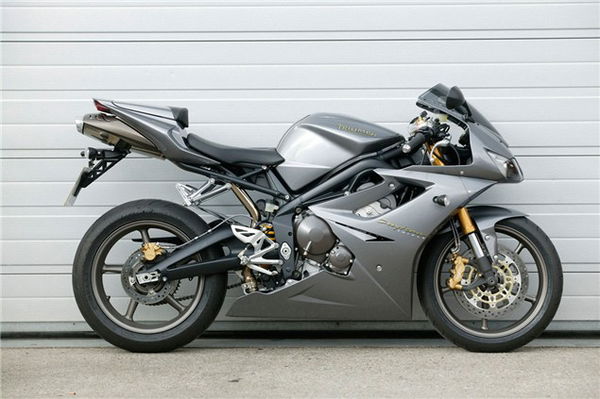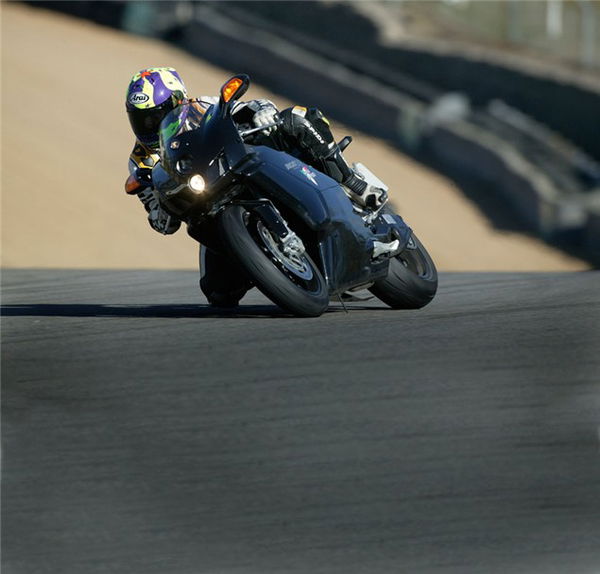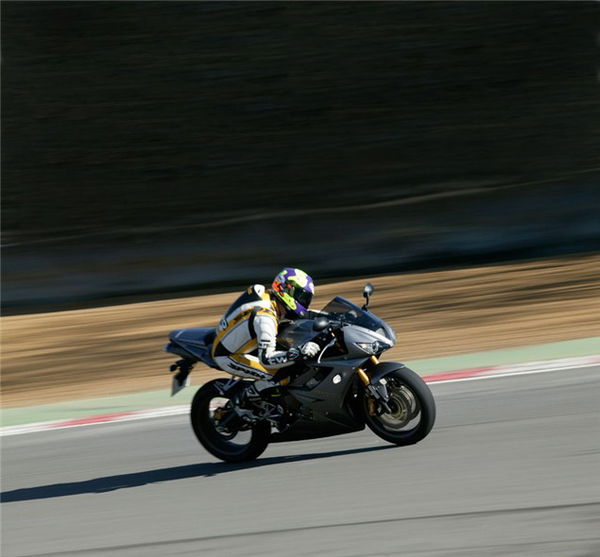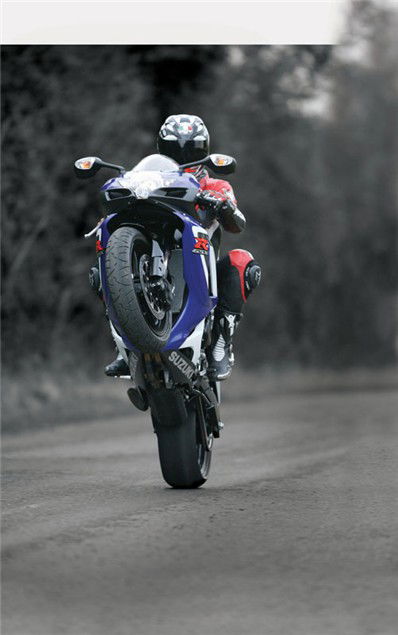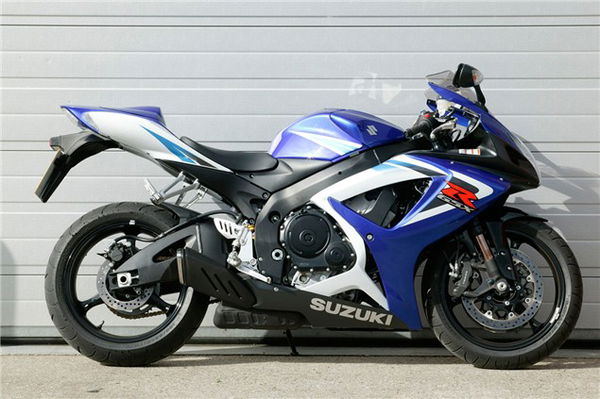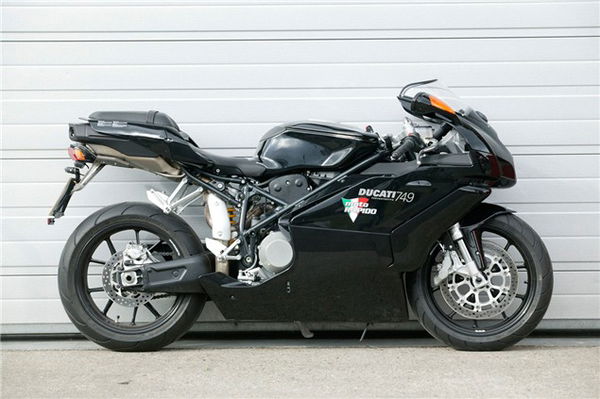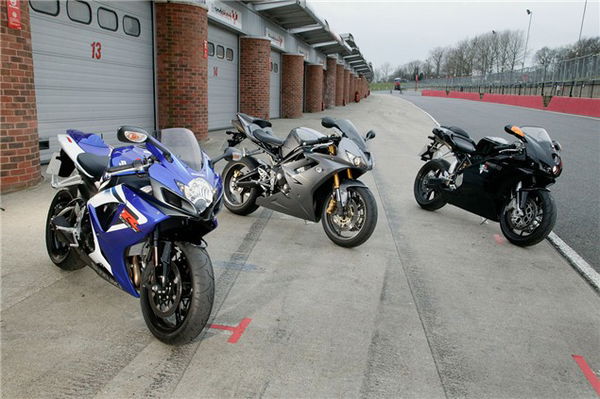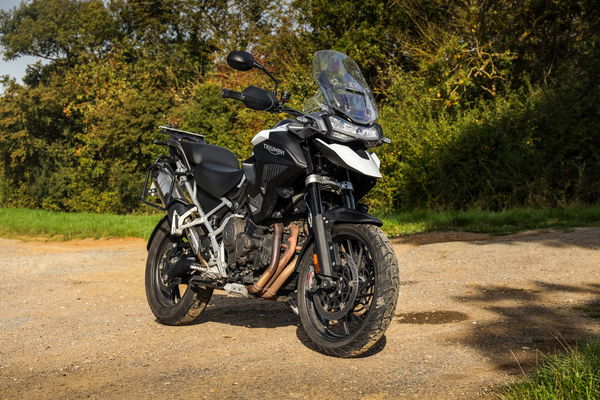Road Test: Ducati 749 v GSX-R750 K6 v 675 Daytona
Oversized 600s or underpowered1000s? With choices like these now is the time to think outside the box and dip into the middle ground.

Whitham is happy again. "I've got my Paddock Hill mojo back,"he giggles after his first session on the GSX-R750. "I love it when you get Paddock right - you go in really deep and it feels like you're going to fall off the edge of the world, but then you drop down and think 'I could have gone faster.' It scares me, and I like that."
Along with four other riders I got a grandstand view of this mojo moment as James came flying around the outside and into Paddock at a terrifying rate of knots. Doing road tests for TWO I have the privilege of riding on track with both Niall Mackenzie and James, and as anyone who has ever followed, no matter how briefly, a genuinely fast rider will know it can be a humbling experience. But when either of them really start pushing on a bit, it's quite simply staggering to watch. This was James on the GSX-R.
Back in the pits he continued to enthuse:"It's so good this bike, it just drags you on, encourages you to go even faster. Usually I like to spend a bit of time getting used to a bike, but after about 10 laps with the Suzuki I felt like I'd known it for ages. It makes you want to play. I expected it to be good, but not this good. Everything just feels right."
You have to admire Suzuki for still making the GSX-R750. All the other manufacturers jumped ship when the 750 class fell out of favour with the advent of kick-arse litre machines, but not Suzuki. Despite the 1000s taking over the production and superbike racing mantle, and the 600s becoming the new screamer class, Suzuki is still proudly making and updating the GSX-R750.
But why? Ask a Suzuki person and they will talk about heritage. The GSX-R750 did an awful lot to put the Suzuki name on the map in the 80s and 90s, and that same Suzuki person will throw in words like 'passion' and 'brand strength'. But is it simpler than that? Is there simply someone at Suzuki who recognises that a 750cc bike hits the elusive nail of power and balance right on the head? And sod those who think that a bike should conform to a certain class.
But there's more to this test than the GSX-R. What we have here at Brands are three class rebels, bikes that shun pigeonholing into a dictated format and refuse to go with the flow.
The GSX-R750 is a hangover from a long-dead class, but what about Triumph's new 675? The beauty of the 675 is that Triumph simply refused to follow suit, which is what the firm should have done long ago. The company spent four years chasing the dream of matching the Big Four in the 600 class, and that was always going to be a fruitless task. But the Daytona 675 is different.
Rather than conform Triumph has taken an engine format it has a reputation for - the inline triple - and made a sporty bike for it to sit in. So what if it's an odd size? It could have been any capacity, but just happens to be a 675. And it works very well.
"This is genuinely a very good bike," reckoned James after a session on the Daytona. "In the past you would have to make allowance for the fact it was a Triumph, and it was British. Head-to-head against the Japanese it were always, 'that's good, for a Triumph,' rather than 'it's better than a Japanese bike,' but this is different. What a little beauty. I like the way it feels like you're sat on top of it; it steers lovely and the suspension and geometry, while not the fastest, just feels right. Really nice."
Which just leaves us with the Ducati 749, which in a way is the only one that actually fits into a class... almost. The 749 is Ducati's answer to a 600, but it isn't because it's a 750. But Ducati's answer to a 750 was a 999, so it doesn't fit in this class. It's all about the number of cylinders, you see. Confused? Well, try this. It isn't even a 749. The only 749 that actually has 749cc is the 749R, because that's the bike homologated for supersport racing. So what, exactly, is the 749?
Quite simply, the 749 is a bike made for people who want a sporty Ducati that looks like the superbike, has superbike handling and decent power, but doesn't cost as much. There is over £2500 difference between a 749 and even the base model 999 - even more if you go for the budget 749 Dark. For that you get a superbike-derived chassis and motor in a bike that looks just like the one on telly. And, like most Ducatis, it works.
"It feels so strange to sit on, really long and low," reckoned James after his first stint on the Italian twin, "and it takes some turning-in compared to the Triumph and Suzuki. But once turned it's so steady and neutral. Sounds silly but it really wants to go around corners. Some bikes need forcing into a corner; the Ducati just goes around."
The beauty of the 749 is that you can be so lazy with it. It even rewards lazy riding. Rev it too much and you'll just tire yourself out. Instead take it easy, leave it in one gear and float along on the torque.
"To start with I tried to be aggressive with the Ducati," said James, "but after a few laps I settled down and it really started to work. The engine's good, really smooth, but for me a twin needs a bloody big motor. The 749's motor is okay, but it doesn't have the midrange I'm expecting."
This is the problem with V-twins: even when they're making good power they just don't feel fast, and getting big power out of them is an effort. For their 999 range Ducati has been forced to really up the ante to chase the 160bhp the inline fours are making, but the smaller capacity 749 only makes 103bhp, which is less than most 600s. Yes,it has a fairly healthy 56lb.ft of torque, but torque doesn't really provide thrills - revs and horsepower do that. Torque equals usability, which is why the 749 takes less effort to ride on track.
So if revs mean thrills and torque means ease of use, where does this leave the 675's engine which, being a triple, should offer the best of both worlds?
"For a while I just didn't know how to ride the 675 engine," said a perplexed James. "It feels like a rough four, so I tried to rev it, but then I tried using the midrange, and it was just as good. It's not like anything I've ridden before, it's got a really broad spread of power and you have to use the whole rev range."
You have to completely re-calibrate your brain to ride the 675. Twins are easy, just use the midrange and change gear early. Inline fours? Change when the rev limiter kicks in. But the 675 needs riding in the mid- to upper midrange, the motorcycle engine's grey area, if you will. Once you work this out it is a beautiful motor which really does combine the best of both worlds, but up until then you'll find yourself hitting the rev limiter as you confuse it for an inline four, or think it's slow as you try and ride it like a twin.
"Once I worked the motor out I loved the Triumph," said James. "Where the old Daytona 600 and 650 felt like they were made up of five-year-old rejected Honda components, this feels like everything has been made for it, and it works beautifully. The brakes are mega sharp, the chassis balanced and the motor's beautiful - a great sound and power everywhere you want it. On the track it was great, on the road it were even better."
While all three bikes are excellent on the track, their real trump card is on the road. It's often said about the modern 600s being like wind-up toys. Well, because of their odd engine sizes these bikes overcome that problem.
On the road the 749's midrange makes it so easy to ride. The engine is lovely to use, because this is where you really want to be lazy. If you're not in the mood for screaming revs everywhere the torque is on tap to calm the ride. But while the engine is calming the rest of the bike is less so. The riding position is crippling through town, the clutch is too heavy and the mirrors crap. But if you want a sporty Ducati this is all part of the experience.
On track the GSX-R offers the handling of a 600 but with more power; in the real world the 750 becomes more and more like the perfect bike. It still retains the handling of the 600, but the benefit of the extra midrange is highlighted by the nature of road riding and, while it is still very, very fast, it doesn't quite have the 1000's ability of building speed without noticing. On a GSX-R1000 it's all too easy to stray above 100mph and way, way beyond because of the excess of horsepower on tap. The 750's engine needs to be worked that bit harder, so it's much easier to keep speed in check.
"It just gets better and better this bike," reckoned a smitten James. "I don't see why anyone would chose a 600 over it; the 600 doesn't have any benefits."
Well, how about a 675? As Niall found out on the launch the 675 is a better road bike than track bike, and it's very, very good on track. Triumph tends to design its bikes for the road, and any sporting aspirations are an afterthought. This is why Triumph's suspension is often a bit soft for hard track use. The 675 seems to hit the perfect balance between softness for comfort and stiffness for handling, while the three-cylinder engine, which always seems to be able to deliver usable power, complements the chassis superbly. It's not perfect - taller riders may find the 675's riding position a bit of a squeeze because it really is tiny with a very racy head-down bum-up position - but it does get better the faster you go. Much like the Ducati.
So why do these bikes exist at all, and what kind of owner should be looking to them to find salvation?
If you want a Ducati, you want one. That seems to be how it works. The 749 is a great road and track bike which, when compared to the 999, is good value for money. If cash isn't an issue the extra power of the latest 999 is very useful, but pound for pound the 749 is a good bet. It has limitations, but owners seem happy to put up with them. Character, I guess.
If you're looking at buying a new supersport 600 then stop and give the GSX-R750 and Daytona 675 some very serious consideration. The 675 is, finally, a genuine contender from Triumph and a serious option to the Japanese 600s. It makes a better road bike thanks to the torquey triple motor, and is as happy on the track as it is on the road. It may not have all the latest bells and whistles such as slipper clutches and electronic throttles, but it is a damn sight easier and more relaxing to ride - and makes a beautiful sound while you're doing so. As James said at the end of the day, "there really is no reason not to buy the 675."
But the bike that really won everyone over is the GSX-R750. We all knew it would be good, but just how good? The answer is, it's stunning. I can't see any reason why anyone would buy a 600 over the 750. The 750 is better in every single respect.
Our advice? Only dead fish follow the flow, so think a little different. Rules are made to be broken, and these three bikes do it very, very well.
WHITHAM'S SECOND OPINION - SUZUKI
I've done a bit of riding on the '05 GSX-R and have bashed on about what a good tool it is, so in my mind the '06 model had some big boots to fill. And fill 'em it does. I like most things about this bike. The styling is cool, the steering sharp, the brakes are good and the engine is strong and tractable. I was having so much fun round Brands I couldn't help going daft on it. If I were forced to choose a stock road bike to try for a quick lap time on, I'd choose this one.
The GSX-R is as good on the road too. The only things I could find to whinge about were the footrests, which moved back against their springs too easily, and the suspension, which felt fairly harsh if the roads were really bumpy. Overall the Suzuki is sharp and fast enough to be exciting, but not so fast you have to ride at half throttle all the time. Definitely worth considering if you're running a 600 and you'd like a bit more power or, conversely, you've got a litre sports bike that keeps scaring the god bejeezus out of you.
WHITHAM'S SECOND OPINION - TRIUMPH
Despite its good looks and despite Niall's favourable rantings, I was still surprised just how good the 675 was to ride. I wasn't impressed with how high up you feel, or by the colour scheme, or by the dash, which looks like the ones you get on a TT arcade game, but once I got going I liked the 675.
Handling is mint. It steers quickly and accurately enough to be fun on track, but is stable enough to feel safe on the road. I also loved the motor. The combination of one less cylinder and 75ccs more than most other middleweights give it midrange without losing much top end or character. The brakes were as good as any in class and better than most, and the steering damper was a nice touch. The 675 is just as happy dawdling along in a high gear as it is being slung round Brands revving to within an inch of its life. Make no mistake, whatever kind of riding you do, and whatever your ability, this is one cracking bike.
WHITHAM'S SECOND OPINION - DUCATI
While the 749 is aimed at much the same market as the other two, it differs in many ways. For a start the seat is much lower than most sports bikes. Fine for me and a selling point to some, but I don't know how comfy a big bloke would feel on it.
The handling, especially steering and change of direction, is a bit slow for me, but once in the corner the Duke feels neutral and sure-footed, like you could jump off and it would keep going round. I have to admit I was disappointed with the engine. Power is spread out so you never get a kick in the arse, and you're always waiting for something exciting to happen. On the positive side, the way you only have to touch the starter and then leave the 749 to go through it's own start-up procedure is nice, as is the sound and feel of the engine.
The Duke is capable and pleasant, and the things that turned me off would be features some riders will love.
SPECS - DUCATI
TYPE - SUPERSPORTS
PRODUCTION DATE - 2006
PRICE NEW - £8795
ENGINE CAPACITY - 748cc
POWER - 103bhp@10,100rpm
TORQUE - 55.6lb.ft@8300rpm
WEIGHT - 197kg
SEAT HEIGHT - 780mm
FUEL CAPACITY - 15.5L
TOP SPEED - 145.9mph
0-60 - n/a
TANK RANGE - 115miles
SPECS - SUZUKI
TYPE - SUPERSPORTS
PRODUCTION DATE - 2006
PRICE NEW - £7799
ENGINE CAPACITY - 749cc
POWER - 133.2bhp@11,500rpm
TORQUE - 66.5lb.ft@8700rpm
WEIGHT - 163kg
SEAT HEIGHT - 810mm
FUEL CAPACITY - 16.5L
TOP SPEED - 154.4mph
0-60 - n/a
TANK RANGE - 120miles
SPECS - TRIUMPH
TYPE - SUPERSPORTS
PRODUCTION DATE - 2006
PRICE NEW - £7199
ENGINE CAPACITY - 675cc
POWER - 107.2bhp@10,900rpm
TORQUE - 54.2lb.ft@9200rpm
WEIGHT - 165kg
SEAT HEIGHT - 835mm
FUEL CAPACITY - 17.4L
TOP SPEED - 149.8mph
0-60 - n/a
TANK RANGE - 120miles

Oversized 600s or underpowered1000s? With choices like these now is the time to think outside the box
and dip into the middle ground.
Whitham is happy again. "I've got my Paddock Hill mojo back,"he giggles after his first session on the GSX-R750. "I love it when you get Paddock right - you go in really deep and it feels like you're going to fall off the edge of the world, but then you drop down and think 'I could have gone faster.' It scares me, and I like that."
Along with four other riders I got a grandstand view of this mojo moment as James came flying around the outside and into Paddock at a terrifying rate of knots. Doing road tests for TWO I have the privilege of riding on track with both Niall Mackenzie and James, and as anyone who has ever followed, no matter how briefly, a genuinely fast rider will know it can be a humbling experience. But when either of them really start pushing on a bit, it's quite simply staggering to watch. This was James on the GSX-R.
Back in the pits he continued to enthuse:"It's so good this bike, it just drags you on, encourages you to go even faster. Usually I like to spend a bit of time getting used to a bike, but after about 10 laps with the Suzuki I felt like I'd known it for ages. It makes you want to play. I expected it to be good, but not this good. Everything just feels right."
You have to admire Suzuki for still making the GSX-R750. All the other manufacturers jumped ship when the 750 class fell out of favour with the advent of kick-arse litre machines, but not Suzuki. Despite the 1000s taking over the production and superbike racing mantle, and the 600s becoming the new screamer class, Suzuki is still proudly making and updating the GSX-R750.
But why? Ask a Suzuki person and they will talk about heritage. The GSX-R750 did an awful lot to put the Suzuki name on the map in the 80s and 90s, and that same Suzuki person will throw in words like 'passion' and 'brand strength'. But is it simpler than that? Is there simply someone at Suzuki who recognises that
a 750cc bike hits the elusive nail of power and balance right on the head? And sod those who think that a bike should conform to a certain class.
But there's more to this test than the GSX-R. What we have here at Brands are three class rebels, bikes that shun pigeonholing into a dictated format and refuse to go with the flow. The GSX-R750 is a hangover from a long-dead class, but what about Triumph's new 675? The beauty of the 675 is that Triumph simply refused to follow suit, which is what the firm should have done long ago. The company spent four years chasing the dream of matching the Big Four in the 600 class, and that was always going to be a fruitless task. But
the Daytona 675 is different.
Rather than conform Triumph has taken an engine format it has a reputation for - the inline triple - and made a sporty bike for it to sit in. So what if it's an odd size? It could have been any capacity, but
just happens to be a 675. And it works very well.
"This is genuinely a very good bike," reckoned James after a session on the Daytona. "In the past you would have to make allowance for the fact it was a Triumph, and it was British. Head-to-head against the Japanese it were always, 'that's good, for a Triumph,' rather than 'it's better than a Japanese bike,' but this is different. What a little beauty. I like the way it feels like you're sat on top of it; it steers lovely and the suspension and geometry, while not the fastest, just feels right. Really nice."
Which just leaves us with the Ducati 749, which in a way is the only one that actually fits into a class... almost. The 749 is Ducati's answer to a 600, but it isn't because it's a 750. But Ducati's answer to a 750 was a 999, so it doesn't fit in this class. It's all about the number of cylinders, you see. Confused? Well, try this. It isn't even a 749. The only 749 that actually has 749cc is the 749R, because that's the bike homologated for supersport racing. So what, exactly, is the 749?
Quite simply, the 749 is a bike made for people who want a sporty Ducati that looks like the superbike, has superbike handling and decent power, but doesn't cost as much. There is over £2500 difference between a 749 and even the base model 999 - even more if you go for the budget 749 Dark. For that you get a superbike-derived chassis and motor in a bike that looks just like the one on telly. And, like most Ducatis, it works.
"It feels so strange to sit on, really long and low," reckoned James after his first stint on the Italian twin, "and it takes some turning-in compared to the Triumph and Suzuki. But once turned it's so steady and neutral. Sounds silly but it really wants to go around corners. Some bikes need forcing into a corner; the Ducati just goes around."
The beauty of the 749 is that you can be so lazy with it. It even rewards lazy riding. Rev it too much and you'll just tire yourself out. Instead take it easy, leave it in one gear and float along on the torque.
"To start with I tried to be aggressive with the Ducati," said James, "but after a few laps I settled down and it really started to work. The engine's good, really smooth, but for me a twin needs a bloody big motor. The 749's motor is okay, but it doesn't have the midrange I'm expecting."
SPECS - DUCATI 749
TYPE - SUPERSPORTS
PRODUCTION DATE - 2006
PRICE NEW - £8795
ENGINE CAPACITY - 748cc
POWER - 103bhp@10,100rpm
TORQUE - 55.6lb.ft@8300rpm
WEIGHT - 197kg
SEAT HEIGHT - 780mm
FUEL CAPACITY - 15.5L
TOP SPEED - 145.9mph
0-60 - n/a
TANK RANGE - 115miles

"For a while I just didn't know how to ride the 675 engine," said a perplexed James. "It feels like a rough four, so I tried to rev it, but then I tried using the midrange, and it was just as good. It's not like anything I've ridden before, it's got a really broad spread of power and you have to use the whole rev range."
You have to completely re-calibrate your brain to ride the 675. Twins are easy, just use the midrange and change gear early. Inline fours? Change when the rev limiter kicks in. But the 675 needs riding in the mid- to upper midrange, the motorcycle engine's grey area, if you will. Once you work this out it is a beautiful motor which really does combine the best of both worlds, but up until then you'll find yourself hitting the rev limiter as you confuse it for an inline four, or think it's slow as you try and ride it like a twin.
"Once I worked the motor out I loved the Triumph," said James. "Where the old Daytona 600 and 650 felt like they were made up of five-year-old rejected Honda components, this feels like everything has been made for it, and it works beautifully. The brakes are mega sharp, the chassis balanced and the motor's beautiful - a great sound and power everywhere you want it. On the track it was great, on the road it were even better."
While all three bikes are excellent on the track, their real trump card is on the road. It's often said about the modern 600s being like wind-up toys. Well, because of their odd engine sizes these bikes overcome that problem.
On the road the 749's midrange makes it so easy to ride. The engine is lovely to use, because this is where you really want to be lazy. If you're not in the mood for screaming revs everywhere the torque is on tap to calm the ride. But while the engine is calming the rest of the bike is less so. The riding position is crippling through town, the clutch is too heavy and the mirrors crap. But if you want a sporty Ducati this is all part of the experience.
On track the GSX-R offers the handling of a 600 but with more power; in the real world the 750 becomes more and more like the perfect bike. It still retains the handling of the 600, but the benefit of the extra midrange is highlighted by the nature of road riding and, while it is still very, very fast, it doesn't quite have the 1000's ability of building speed without noticing. On a GSX-R1000 it's all too easy to stray above 100mph and way, way beyond because of the excess of horsepower on tap. The 750's engine needs to be worked that bit harder, so it's much easier to keep speed in check.
"It just gets better and better this bike," reckoned a smitten James. "I don't see why anyone would chose a 600 over it; the 600 doesn't have any benefits." Well, how about a 675? As Niall found out on the launch the 675 is a better road bike than track bike, and it's very, very good on track. Triumph tends to design its bikes for the road, and any sporting aspirations are an afterthought. This is why Triumph's suspension is often a bit soft for hard track use. The 675 seems to hit the perfect balance between softness for comfort and stiffness for handling, while the three-cylinder engine, which always seems to be able to deliver usable power, complements the chassis superbly. It's not perfect - taller riders may find the 675's riding position a bit of a squeeze because it really is tiny with a very racy head-down bum-up position - but it does get better the faster you go. Much like the Ducati.
So why do these bikes exist at all, and what kind of owner should be looking to them to find salvation?
If you want a Ducati, you want one. That seems to be how it works. The 749 is a great road and track bike which, when compared to the 999, is good value for money. If cash isn't an issue the extra power of the latest 999 is very useful, but pound for pound the 749 is a good bet. It has limitations, but owners seem happy to put up with them. Character, I guess.
If you're looking at buying a new supersport 600 then stop and give the GSX-R750 and Daytona 675 some very serious consideration. The 675 is, finally, a genuine contender from Triumph and a serious option to the Japanese 600s. It makes a better road bike thanks to the torquey triple motor, and is as happy on the track as it is on the road. It may not have all the latest bells and whistles such as slipper clutches and electronic throttles, but it is a damn sight easier and more relaxing to ride - and makes a beautiful sound while you're doing so. As James said at the end of the day, "there really is no reason not to buy the 675."
But the bike that really won everyone over is the GSX-R750. We all knew it would be good, but just how good? The answer is, it's stunning. I can't see any reason why anyone would buy a 600 over the 750. The 750 is better in every single respect.
Our advice? Only dead fish follow the flow, so think a little different. Rules are made to be broken, and these three bikes do it very, very well.
SPECS - SUZUKI GSX-R750 K6
TYPE - SUPERSPORTS
PRODUCTION DATE - 2006
PRICE NEW - £7799
ENGINE CAPACITY - 749cc
POWER - 133.2bhp@11,500rpm
TORQUE - 66.5lb.ft@8700rpm
WEIGHT - 163kg
SEAT HEIGHT - 810mm
FUEL CAPACITY - 16.5L
TOP SPEED - 154.4mph
0-60 - n/a
TANK RANGE - 120miles
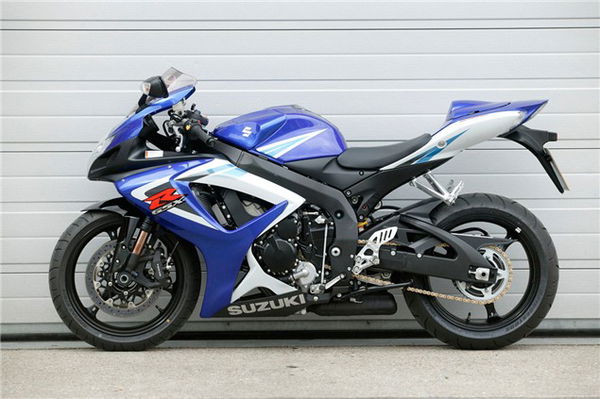
WHITHAM'S SECOND OPINION - SUZUKI
I've done a bit of riding on the '05 GSX-R and have bashed on about what a good tool it is, so in my mind the '06 model had some big boots to fill. And fill 'em it does. I like most things about this bike. The styling is cool, the steering sharp, the brakes are good and the engine is strong and tractable. I was having so much fun round Brands I couldn't help going daft on it. If I were forced to choose a stock road bike to try for a quick lap time on, I'd choose this one.
The GSX-R is as good on the road too. The only things I could find to whinge about were the footrests, which moved back against their springs too easily, and the suspension, which felt fairly harsh if the roads were really bumpy. Overall the Suzuki is sharp and fast enough to be exciting, but not so fast you have to ride at half throttle all the time. Definitely worth considering if you're running a 600 and you'd like a bit more power or, conversely, you've got a litre sports bike that keeps scaring the god bejeezus out of you.
WHITHAM'S SECOND OPINION - TRIUMPH
Despite its good looks and despite Niall's favourable rantings, I was still surprised just how good the 675 was to ride. I wasn't impressed with how high up you feel, or by the colour scheme, or by the dash, which looks like the ones you get on a TT arcade game, but once I got going I liked the 675.
Handling is mint. It steers quickly and accurately enough to be fun on track, but is stable enough to feel safe on the road. I also loved the motor. The combination of one less cylinder and 75ccs more than most other middleweights give it midrange without losing much top end or character. The brakes were as good as any in class and better than most, and the steering damper was a nice touch. The 675 is just as happy dawdling along in a high gear as it is being slung round Brands revving to within an inch of its life. Make no mistake, whatever kind of riding you do, and whatever your ability, this is one cracking bike.
WHITHAM'S SECOND OPINION - DUCATI
While the 749 is aimed at much the same market as the other two, it differs in many ways. For a start the seat is much lower than most sports bikes. Fine for me and a selling point to some, but I don't know how comfy a big bloke would feel on it.
The handling, especially steering and change of direction, is a bit slow for me, but once in the corner the Duke feels neutral and sure-footed, like you could jump off and it would keep going round. I have to admit I was disappointed with the engine. Power is spread out so you never get a kick in the arse, and you're always waiting for something exciting to happen. On the positive side, the way you only have to touch the starter and then leave the 749 to go through it's own start-up procedure is nice, as is the sound and feel of the engine. The Duke is capable and pleasant, and the things that turned me off would be features some riders will love.
SPECS - TRIUMPH 675 DAYTONA
TYPE - SUPERSPORTS
PRODUCTION DATE - 2006
PRICE NEW - £7199
ENGINE CAPACITY - 675cc
POWER - 107.2bhp@10,900rpm
TORQUE - 54.2lb.ft@9200rpm
WEIGHT - 165kg
SEAT HEIGHT - 835mm
FUEL CAPACITY - 17.4L
TOP SPEED - 149.8mph
0-60 - n/a
TANK RANGE - 120miles
